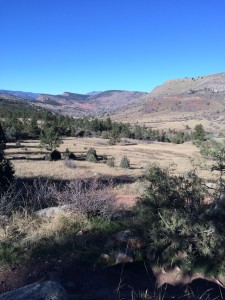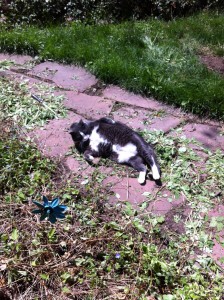Rambling: Christmas and the Winter Solstice
 This Morning’s Commute Scenery
This Morning’s Commute Scenery
Well we just passed the winter solstice a couple days ago. This is when we experience the longest night/shortest day of the year in the northern hemisphere. The daylight hours grow longer and the sun climbs higher in the ski for the next six months until the summer solstice. Since the hours of daylight and angle of the sun’s rays determine the average temperature, you might expect that the solstice would be the coldest day of the year, on average anyway.
Actually the coldest average temperature happens about a week after the solstice. The reason is because the earth and atmosphere act as a heat reservoir. This reservoir leaks heat continuously and is replenished by the sun. During the winter, the sun decreases its fill rate and eventually the heat leaking into space is greater than the replenish rate and the earth cools. So even though the sun is turning up its heating spigot after the solstice, it takes a few days before the replenish rate matches the heat loss rate. The same thing happens on a shorter time scale during the day. The hottest part of the day is not at noon but an hour or so later.
Ok, science lesson over.
Next: In two days it will be Christmas. This may or may not be the date Christ was born, but I find it very surprising that it happens only three or four days on the bright side of the solstice. Given that solstice celebrations are far more ancient and were widely practiced all over the northern hemisphere, it seems highly likely that Christmas day was set to coincide with these celebrations. There are of course arguments on both sides of this issue, but it remains that Christmas is now a de facto solstice celebration.
And now my conclusion: The reason we experience varying daylight hours, longer in the summer and shorter in the winter, is because the rotation axis of the earth is tilted 23 degrees from the plane that defines the earth’s orbit around the sun. If the axis were zero, day and night would be exactly the same length for the entire year. If the tilt were greater than 23 degrees, all kinds of freaky things would be different. Think about it for a few minutes.
That 23 degree axial tilt is the main driver of the seasons, and the Winter solstice is the inflection point of daylight hours and warming temperatures. It is something to celebrate.
SO… What is the true meaning of Christmas? 23 degrees.

Posted in Journal by Mark with comments disabled.
Moab
 Rock Formation in Canyonlands National Park
Rock Formation in Canyonlands National Park
Over the Thanksgiving holidays we headed out to Moab, Utah, with the intent of mountain biking for a couple of days with a group of holiday “orphan” friends. The weather didn’t cooperate, it was overcast with snow and rain, and never got much above 35 degrees. And because the trails were a muddy mess, we ended up doing a couple of hikes instead.
The first was a 10 mile hike to the confluence of the Green and Colorado rivers in Canyonlands National Park. There was a tiny bit of snow on the trail and we noted that it would be super easy to get off track if the trail got completely covered and you weren’t paying attention to where you were going. Below are Ken and Shelly at the beginning of our trip.
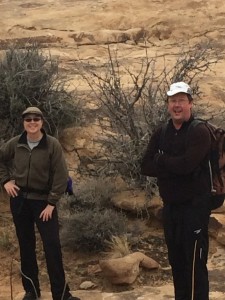 After a bit of up and down hiking, including a ladder that climbs 20 feet up a slickrock cliff, some easy rock scrambling and a bunch of desert sand, you arrive at a spectacular overlook above the confluence, shown below. Green River is on the left, the Colorado River on the right:
After a bit of up and down hiking, including a ladder that climbs 20 feet up a slickrock cliff, some easy rock scrambling and a bunch of desert sand, you arrive at a spectacular overlook above the confluence, shown below. Green River is on the left, the Colorado River on the right:
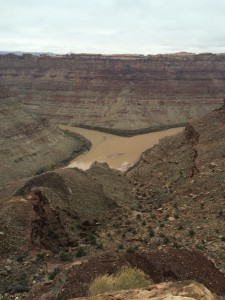 They don’t call it Canyonlands for nothin’!
They don’t call it Canyonlands for nothin’!
A few of us also did another hike in Arches National Park. Got stuck a couple of times on mud covered slickrock and had to downclimb some steep cliffs. Unfortunately I do not have photos of those “kodak moments,” all my mental effort went into getting down those cliffs. All in all a fun trip!
Posted in Journal by Mark with comments disabled.
Windy Days Hike
Trail Sign Pointing The Way
A couple of weekends ago we visited the newly reopened Lyons, CO to do a 10 mile hike with our friends Ann and Gary, who live in Lyons.. The drive into town reveals the amazing devastation of the September flood. Neither Ann’s or Gary’s house was damaged, but Ann could not live in her place due to lack of gas, electricity, water and sewage utilities. They finally got the utilities working but the town remains highly damaged and probably will be that way for a long time. We lived in Lyons for many years and it was shocking to see landmarks that are likely wiped out forever.
Nevertheless, we hiked a loop from Ann’s house through Heil Ranch Open Space on the Picture Rock Trail. The temperature was mild for November but the wind was so high at the beginning that we had a hard time crossing the flats prior to getting into the forest and on the actual trail. It’s that time of year again, the winter winds will soon dominate the high country. I’ve noticed this happens around New Year’s Day. A windless day above timberline is the exception during the winter in the Front Range north of I-70. Below is a GPS track of our hike. The town of Lyons is in the upper center part of the map.
Lucky for us the wind died down by late morning and the rest of the day was beautiful. Lots of mountain bikes on this trail, which is annoying if you are hiking but I personally have no complaints. Mountain bikers need a place to ride too, and many of the trails in the central Boulder mountain parks, where I hike very often, ban bikes.
The hike was nothing spectacular except to get out and enjoy a really nice day!
Posted in Journal by Mark with comments disabled.
Romanticized Adventure

142 Fairbanks City Bus – Image copyright Christopher Johnson McCandless Memorial Foundation
I’ve found it fascinating how the story of Christopher “Into the Wild” McCandless has become legendary. It touches on a deep spirit of adventure that is common among most people, whether they express, or even recognize it, or not. I’ve noticed that this story tends to polarize people into one of two camps: McCandless was a reckless fool, or McCandless was a noble adventurer pushing the limits. Whatever your opinion, it probably rises from the same basic emotion involving a fascination with adventure.
W.B. Churchill was seeking something with far more depth and seriousness in the same sort of wilderness isolation that I wrote about in the book Forty Demons. It also appears likely that Dustin Self was also on a similar kind of extreme adventure.
However, the poor young man in this incident, if you can believe what is written in the online story, is not in the same category. Jonathan Croom was reported to be distraught before he disappeared, unlike McCandless, Churchill or Self, who were all on epic adventures of self-discovery. He was found a short distance from his SUV, not in a remote wilderness area, days from civilization. If the 18-year-old Croom committed suicide as the authorities believe, they probably have evidence of the fact. Both Churchill and McCandless were initially thought to have made mistakes that trapped them in a remote area, their bodies weren’t found 1000 feet from their car.
Unfortunately, the media has apparently decided that because there was a remote link to the McCandless story, they decided to exploit the tragic death of Jonathan Croom. Croom must have been “inspired” to go off into the Oregon wilderness and try and adventure for himself. Perhaps he was in some way, but the reality seems to be that it’s an attention grabber for a media outlet desperate for web hits. Note all the photos of McCandless and publicity photos from the “Into the Wild” movie, both of which have only the most remote connection to Croom.
The terrible downside to this is the romanticizing the mix of McCandless’ adventure and tragedy into a seductive death-wish archetype that can be so appealing to young adults. This is a good example of irresponsible media at it’s worst. The least the media could do is publish stories about actual tragic adventures of self-discovery, there are plenty around.
Posted in 40 Demons Archive, Journal by Mark with 2 comments.
Alum Rock Park Hike

Overlooking Silicon Valley
So here’s a good one… My company flew me out to San Jose, CA, to attend an important all-day meeting. When I showed up this morning, the women handing out the passes at the desk in front of the auditorium, also known as “the gatekeepers,” or perhaps, “the Nazgul,” informed me my name was not on the list and then promptly ignored me like I wasn’t standing there. I couldn’t even ask a question! I had flown out from Colorado and was being snubbed like I was a groupie outside a swank nightclub. From my own company! Well, whatever, it was on their dime, not mine. And yes, I checked, I’m still employed…
Anyway, whatever. I wasn’t going to waste the day so I went on a hike in Alum Rock Park on the east side of Silicon Valley, about 9 miles from where I was staying. California is a monument to contrasts and this was no exception. Less than ten miles from the unending crowds and congestion is wide open wilderness. The weather was fantastic, far too hot actually, probably 90 degrees. An hour hike takes you up what would be a foothill in Colorado, but with a very nice view of San Jose and the rest of the valley south of San Francisco, pictured above (not my photo).
Not one other person on the trail all day!
Posted in Journal by Mark with comments disabled.
Quanti Experientiam?

Pyramid Peak, Thunder Pyramid is on the ridge to the right
What is the price of experience?
A couple weeks ago a climber was killed while descending one of the more hazardous peaks near Aspen. Though these incidents are always sadly tragic, this particular accident received a lot of attention from the Colorado mountaineering community because the victim was a highly experienced climber who was widely known and well loved by both his peers and protégés. Though all climbing disasters are unique in their way, a few things stand out for me about this one.
The climber who died was Steve Gladbach, a high school teacher in Pueblo. On June 23rd, he and two partners summited a peak known as “Thunder Pyramid,” a point on a ridge connected to the summit of Pyramid Peak, one of Colorado’s 14,000 foot peaks. Thunder Pyramid is not an officially named peak and was actually christened “Thunder Peak,” by a party that claimed the first ascent in 1970. It is not considered a separate peak but is climbed fairly often by “point baggers” who want to climb every possible high point named (or not) in some guidebook somewhere. If you think it takes a lot of determination to climb all of Colorado’s 14ers, consider how much work and determination it takes to bag every high point around all the 14ers and possibly all the 13ers. Gladbach counted himself as one of these persistent climbers.
On the descent from Thunder Pyramid, Gladbach intentionally separated from his climbing partners. His partners later reported that Gladbach wanted to check out another route possibility. They agreed to meet up later at an appointed time and place below and continue descending. Gladbach never showed up and so his partners called for help. Apparently, Gladbach also called for help using his SPOT beacon. Because of the late hour when the call for help was received, Mountain Rescue Aspen was unable to locate Gladbach until the next morning when they found him deceased.
No one witnessed the accident but it was reported that it appeared he died after a fall of hundreds of feet. This is certainly possible, the mountains in the Elk Range are very fractured, loose and steep, kind of like a bunch of rocks stacked on top of each other for thousands of feet. Spontaneous rockfall in this area is very common and makes the area extremely dangerous, it is foolish to climb here without a rock helmet. And you might step on a Volkswagen-sized boulder and cause it to roll down the face.
Ironically, Gladbach died directly across the valley where he was involved in another deadly accident on Maroon Peak almost exactly 21 years earlier with the Colorado Mountain Club. I wrote about the accident, a late season slab avalanche, in a chapter of Colorado 14er Disasters (page 101) “The Dangerous Leader Syndrome” (Gladbach had nothing to do with the title of the chapter). Gladbach was one of the survivors and I never mentioned his name. As a matter of fact, I did not know the names of the participants in that 1992 trip up Maroon Peak when I wrote the book, the description of the accident came from the guy who turned around and the Colorado Avalanche Information Center.
But when Gladbach read the chapter, he became upset because it resurrected many bad memories for him. He sent me an email about how he felt. He had a lot of guilt about that accident which killed two people in his climbing party, though there was certainly no blame directed at him or anyone else. That didn’t matter, reading about it had triggered something that had been buried for years. I apologized but emailed back that it was something that had to be said, I certainly did not single out anyone and indeed did not even know the names of those involved. It reinforced the point with me that these incidents are the most tragic events suffered in the lives of those involved, almost like having a family member or friend killed on the battlefield. I do my best to write about these disasters with the utmost respect but with an unflinching eye toward describing what went wrong.
Gladbach is a pointed example of someone who had a massive amount of experience but still succumbed to an accident that might appear to be immanently preventable. He is not alone in that community. Climbing accidents can happen to anyone!
Posted in Journal by Mark with comments disabled.
Journal
Thinking about building one of these…
Haven’t been very motivated to write much in the last two weeks or so, probably because I haven’t had any interesting adventures. That, plus work, work, work…
Last weekend we were in Steamboat and it was amazingly green, it reminded me of Oregon. Unfortunately I didn’t get any good pics because I forgot my camera at home and the pics I took with my iPhone aren’t that great. Plus I can’t get them to download on my mac for some reason.
Ok, my last post about the Steamboat Marathon, which was run last Sunday. I didn’t actually run it or really even consider it. The posting was an inside joke of sorts. What happened was that in 1992 we went to Steamboat to hang out with some good friends, a couple who was running the marathon. Their race would be the culmination of an extensive and very difficult training regimen they had stuck to for many months. Being a runner myself, I knew how much they suffered to get to that point. I had been training myself but nowhere near the distances they ran, which was about 20 miles regularly. But I did want to run at least one marathon in my life and so… At the last minute I signed up for the race. I thought what the heck, it’s generally downhill and I could probably get through it. I did and was able to struggle to the end, the last 8 miles were excruciating. Both of my friends had rough days, as can happen to anyone, and surprisingly I finished ahead of them. I got lucky, or rather they got unlucky. And of course they’ve been harassing me about this for the last two decades. This is called the Balthazar effect.
So… The photo at the top is a nuclear fusion reactor. Turns out that it is possible to build one of these at home. More on this later…
Posted in Journal by Mark with comments disabled.
Marathon Decisions
Up in Steamboat this weekend and saw the Steamboat Marathon is running tomorrow. Trying to decide if I should run it or not.
Posted in Journal by Mark with comments disabled.
Journal
Possible Sealcat sighting in Boulder?
Well this spring is shaping up to be more normal than the previous two years when we had sweltering, dry weather. Last weekend it warmed up enough to start the big runoff. Lots of snow remains in the foothills and the high peaks look almost solid white. Even Pikes Peak is largely covered snow. 
Gregory Creek which flows just behind our house was running for the first time in probably three years, pic on right.
—————————————————————-
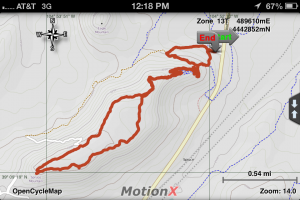 On Sunday we visited Colorado Springs for Mom’s day (hi mom!). On the way home we hiked in a cool open space area just north of Palmer Lake called Spruce Mountain Open Space. GPS track on the left. There is a large trail system for both hikers and mountain bikers. It winds around Spruce Mountain, which is one of the buttes between Castle Rock and Monument, plus through the surrounding prairie. We only hiked about 5 miles, a small portion of the total trail system.
On Sunday we visited Colorado Springs for Mom’s day (hi mom!). On the way home we hiked in a cool open space area just north of Palmer Lake called Spruce Mountain Open Space. GPS track on the left. There is a large trail system for both hikers and mountain bikers. It winds around Spruce Mountain, which is one of the buttes between Castle Rock and Monument, plus through the surrounding prairie. We only hiked about 5 miles, a small portion of the total trail system.
Interestingly, we noticed no pine beetle kill in this area.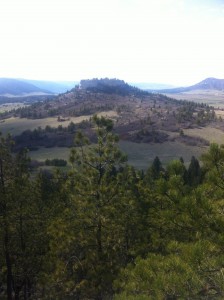 Why is that? There were plenty of spruce trees, which seem to be immune, but we also saw many pine trees. It could be that the beetle hasn’t made it to this area even though they seem to be everywhere in Colorado. One thing that makes this area different is that it gets a lot of moisture. The Palmer Divide seems to catch the most of every storm in the area. I wonder if moisture, or lack of it, drives the pine beetle devastation in the state.
Why is that? There were plenty of spruce trees, which seem to be immune, but we also saw many pine trees. It could be that the beetle hasn’t made it to this area even though they seem to be everywhere in Colorado. One thing that makes this area different is that it gets a lot of moisture. The Palmer Divide seems to catch the most of every storm in the area. I wonder if moisture, or lack of it, drives the pine beetle devastation in the state.
—————————————————————-
Also of interest: As I was leaving for a hike up Flagstaff last weekend, I spotted what may be the first confirmed sighting in modern times of a “sealcat” in Boulder. I was able to get a picture before it rolled away, shown at the top of this post. A sealcat is believed to be a cross between an elephant seal and a domesticated cat. They are dangerous at close distances but only move about as fast as a ground sloth. Like the North American river otter, this species hasn’t been seen in Boulder in a century! I have submitted this photo to the Colorado Division of Wildlife for analysis and possible confirmation.
Journal

Fracture Line of the Sheep Creek Avalanche
Jason Blevins wrote an interesting article about the Sheep Creek avalanche a couple of weeks ago near Loveland Pass. I’ve known Jason for several years, he’s interviewed me for articles about mountaineering accidents. His latest article talks about group dynamics and how it can play a role in making bad decisions. This is a very real phenomenon that is the root of many mountaineering accidents and I wrote about this extensively in Colorado 14er Disasters and Playing for Real. As for the recent avalanche disaster, I’m not so sure. The article doesn’t point to any specific evidence that group dynamics was the root cause of this accident, but it is certainly possible.
————————————————————————
Ok, this week had an unusual national news story about a big “brawl” on Mount Everest between Sherpas and some climbers. The basic story: A group of Sherpas were installing fixed climbing ropes high on an ice slope on Everest when three western climbers wanted to pass. The Sherpas told them to wait but the climbers decided to continue, allegedly knocking ice chunks down on the Sherpas. When the climbers returned to camp, a gang of Sherpas “…punched and kicked the climbers, [and] threw many rocks as well.” The climbers felt their lives were threatened and got the hell out of there, retreating all the way back down the mountain.
Though this news seems terribly shocking to the western world, it is completely expected to those who know the Sherpas and climbing culture in Nepal. I don’t mean the idealized and glorified image that one or two time visitors might see, I mean the actual culture that is only visible if you don’t close your eyes to it. I have had first hand experience with angry Sherpa mobs.
The first was in a very remote little mountain village called Tashigon in 1994. All expeditions to Makalu pass through Tashigon, an area where Sherpas are indigenous. They feel Makalu is their mountain and thus are entitled to take over porter duties, meaning the money, from whomever you had up to that point. Normally this means you pay off the lowland porters and hire these guys (for three times the price) and they get you to base camp. Well, some of the original porters wanted to continue with the expedition and after a big late-night rakshi-fueled party, the fighting started and the Tashigon-ers pulled knives and drove the original porters running out of town in the dark. Kind of like an inner-city street gang.
The second time was much more frightening. It was in 2003. We had just gotten back to Kathmandu after some peak climbs in the Everest region. Shelly and I wanted to move a bunch of gear from one storage facility to another and we recruited our lead Sherpa to help us. We flagged a little taxi and drove to the outskirts of town where our gear was stored and loaded it up. Just as we were about to leave a gang of Sherpas, who also helped us with our climb, showed up and an argument ensued. Our lead guy freaked out and jumped into the taxi and locked the door, telling us the gang that was gathering, growing to about 20 Sherpas, was going to kill him. I tried to get the taxi driver to leave but he walked away saying they would kill him if he tried to drive away.
This confrontation was the result of some incident that happened between the Sherpas weeks before during our expedition. Anyway, the gang opened the doors of the cab and were trying to drag our leader out. I pushed through the crown and tried to close the doors when a rock about the size of my fist cracked our guy in the face (note the “…threw many rocks” reference in the above story). Shelly tried to get the neighborhood’s attention by running down the road screaming for help while I jumped into the drivers seat and started to drive away. The taxi driver, seeing the blood and Shelly’s running scream, ran over to me and said he would drive us away.
Our guy wasn’t seriously hurt and to tell you the truth, Shelly and I were probably not in much personal danger. But it was freaky to witness this street-gang style revenge. To this day the Sherpas in our local Nepali restaurant called Sherpa’s remember this even though we never brought it up. Word spreads fast among this small ethnic tribe, even when they are half way around the world.
The point of this story isn’t that Sherpas are terrible people. They are quite the opposite actually, generally very happy in life and almost overly friendly. In the climbing/trekking world, Sherpas are viewed as almost super-human in strength of both body and character. But in reality, they are human beings.
Bottom line is this: Helping Everest climbers is a job for Sherpas and an extremely dangerous one at that. It pays well relative to other jobs Sherpas could do, but in comparison to western climber’s wealth, it is miniscule. The highest paid Sherpa on an Everest expedition might make $10,000 over the climbing season (the vast majority make less than $500) while a climber might pay six or seven times that amount just to make an attempt. Climbers are on Everest at their discretion and convenience. These guys who got “Sherpa-handled” on Everest are very well known in the high altitude community. Knowing these personality types, my first impression is the climbers ego got away from them and the Sherpas got pissed off, and it probably wasn’t a single event but the result of many smaller confrontations. No doubt there is more to the story we haven’t heard and probably never will, at least not on the national news.
————————————————————————
Wow, another foot of snow fell in Boulder on May 1! It’s been more like February than May this week. Another pic below, it’s hard to see exactly how deep in the photo but it’s about 8 inches. Four more inches fell after this.
Posted in Journal by Mark with comments disabled.


